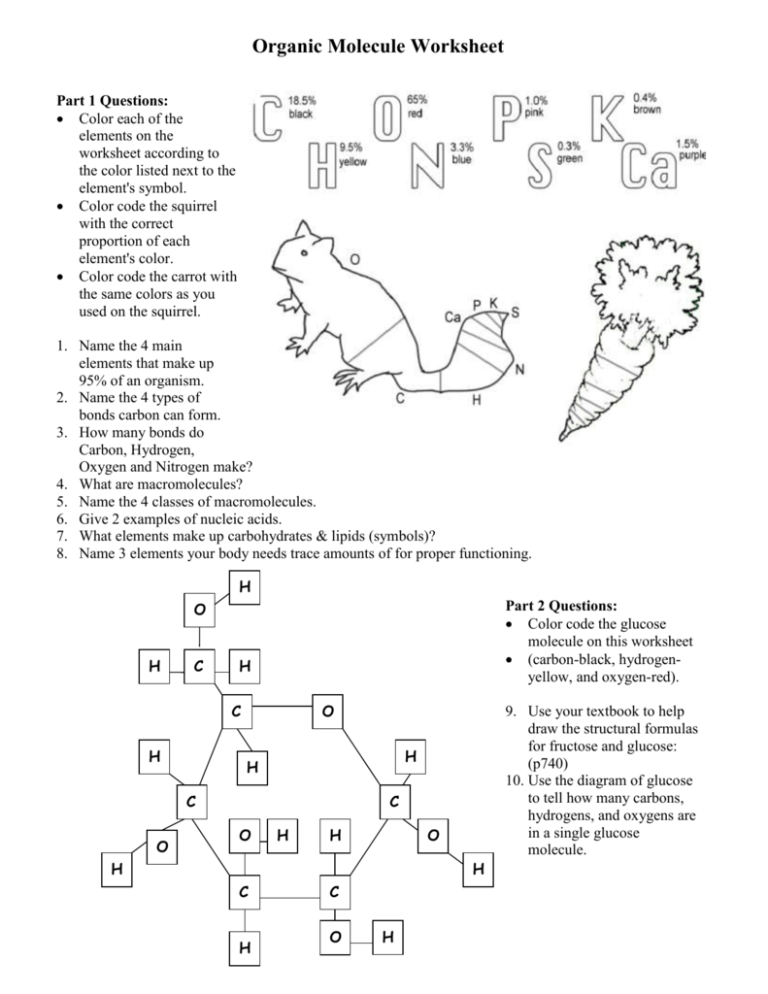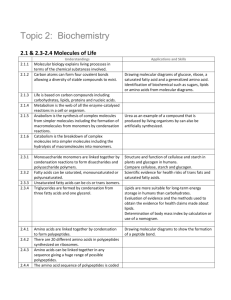Organic Molecule Worksheet
advertisement

Organic Molecule Worksheet Part 1 Questions: Color each of the elements on the worksheet according to the color listed next to the element's symbol. Color code the squirrel with the correct proportion of each element's color. Color code the carrot with the same colors as you used on the squirrel. 1. Name the 4 main elements that make up 95% of an organism. 2. Name the 4 types of bonds carbon can form. 3. How many bonds do Carbon, Hydrogen, Oxygen and Nitrogen make? 4. What are macromolecules? 5. Name the 4 classes of macromolecules. 6. Give 2 examples of nucleic acids. 7. What elements make up carbohydrates & lipids (symbols)? 8. Name 3 elements your body needs trace amounts of for proper functioning. H O H C Part 2 Questions: Color code the glucose molecule on this worksheet (carbon-black, hydrogenyellow, and oxygen-red). H C H O H H C O 9. Use your textbook to help draw the structural formulas for fructose and glucose: (p740) 10. Use the diagram of glucose to tell how many carbons, hydrogens, and oxygens are in a single glucose molecule. C O H H O H H C H C O H Part 2 Questions Continued: 11. If all the macromolecules are made mainly of the elements CHO, how are they different? 12. Name 2 ways your body uses carbohydrates. 13. What are the subunits called that make up carbohydrates? 14. What is the ratio of C, H, and O in monosaccharides? 15. Name 3 monosaccharides. 16. Monosaccharides are ___ sugars. 17. What are disaccharides & give an example? 18. Long chains of sugars are ___. Name three. Part 3 Questions: Color code the amino acid on this worksheet (carbonblack, hydrogen-yellow, nitrogen-blue, and oxygen-red). H H O 19. Use your textbook and sketch an amino acid and circle the amino group and box the carboxyl groups. (p743) N C C 20. What subunits make up proteins? 21. Name the 2 functional groups in amino acids. R group 22. Amino acids are linked together to make proteins by H removing a molecule of ___ in a process called ___. 23. Chains of amino acids make ___ which can join together to make a ___. 24. ___ bonds form when water is removed to hold ___ ___ together. 25. Use your textbook to make a sketch of a dipeptide (2 amino acids linked with a peptide bond) molecule. (p745) Part 4 Questions: Color the glycerol molecule using the same colors for carbon, hydrogen, and oxygen as you did before. Circle and label the carboxyl groups in the 2 fatty acids on this worksheet. Color the fatty acid chains the same colors for carbon, hydrogen, and oxygen as you did before. Saturated fatty Acid H H H H H H H H H H C C C C C C C C C H H H H H H H H H H Glycerol H H C O H H C O H H C O H O C O H H Unsaturated Fatty Acid - Double Bond H H H H H H H H H C C C C C C C C C H H H H H H H H H H O C O H Part 4 Questions Continued: 26. Lipids are nonpolar. What does this mean? 27. What will lipids (oils and fats) dissolve in? 28. ___ makes up cell membranes. 29. Name a waxy lipid covering plants. 30. Plant pigments like ___ are also ___. 31. Lipids have more ___ and ___ than they do oxygen atoms. 32. Fats are made of an alcohol called ___ and three ___ ___ chains. This is known as a ___. 33. If there are all SINGLE bonds between ___ in the fatty acid chain, then it is said to be ___. 34. If there is a DOUBLE bond between ___ in the fatty acid chain, then it is said to be ___. 35. The end of the fatty acid that does NOT attach to glycerol has what functional group? Write the formula for this group. 36. ___ layers of ___ make up the cell membrane. 37. The head of a phospholipid is water ___ and is said to be ___. 38. The 2 tails of a phospholipid is water ___ and is said to be ___. Part 5 Questions: Color and label the parts of a nucleotide - color the sugar (5-sided)-green, phosphate group (round)yellow, and nitrogen base (6-sided)-blue. Color code the ATP and label the phosphates. Nucleotide ATP Part 5 Questions Continued: 39. Nucleic acids carry ___ information in a molecule called ___ or ___ ___ acid. 40. DNA has the instructions for making a cell's ___. 41. The nucleic acid ___ copies DNA so ___ can be made. 42. ___ are the subunits making up nucleic acid. 43. The 3 parts of a nucleotide are a ___ ___, a ___ ___ ___, a ___, and one ___ ___. 44. ___ is a high energy molecule made from a ___ with ___ phosphates. Final Questions: 1. Name the for classes of macromolecules, list the symbols of the elements that make up each and name the subunit(s) that make up each: Name Name Name Name Elements Elements Elements Elements Subunit(s) Subunit(s) Subunit(s) Subunit(s) 2. What process is used to link amino acids together? 3. Name the bonds found between amino acids in a polypeptide chain. 4. Explain the difference between a monosaccharide, a disaccharide and a polysaccharide. Give an example of each. 5. What two functional groups are found in amino acids? 6. Name the subunit that makes up fats. 7. What alcohol is found in a triglyceride? 8. What is the difference between a saturated and unsaturated fatty acid?







